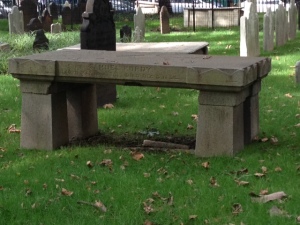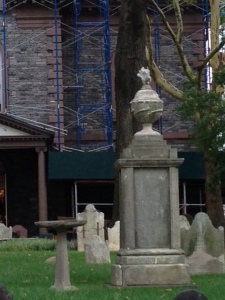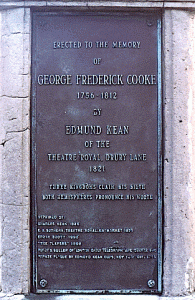Over the weekend, we paid a visit to St. Paul’s churchyard. Located between Versey and Fulton Streets, the spire of St. Paul’s Church still rises above the Broadway. George Washington worshiped there while New York was still the Nation’s capital, and for the eight months after September 11, 2001 St. Paul’s served as a place for emergency workers to stop off for a meal or to sleep. The pews inside still proudly bear the gouges from the firemen’s gear.
Lacking a celebrity burial – Trinity Church’s graveyard is home Alexander Hamilton, Robert Fulton and a whole host of other prominent Americans – St. Paul’s graveyard is comprised of more middle class residents like jockey Samuel Purdy. A famous horseman in his day, Purdy’s prized mount was American Eclipse, undefeated in nearly nine years of racing. In 1823, with sectional tensions rising between North and South in the wake of the Missouri Compromise, the South’s legendary horseman, Colonel William R. Johnson, challenged Purdy and American Eclipse to a best of three races against Sir Henry, his prized four year old. After losing the first race, American Eclipse came back to win the next too, proving the superiority of Northern horseflesh.
Purdy, from what the historical record tells us, was buried complete. Not so George Frederick Cooke. Cooke was one of the great Shakespearian actors of the English stage, and his acting style influenced later Shakespeareans, including Edmund Keane, widely considered the finest of them all.
After a few London performances received less than stellar reviews, Cooke left England and took to the stage in New York, where he was properly appreciated. One overwrought New Yorker gushed “[t]hrobbing invades the heart, when narrating the career of this extraordinary man, of herculean constitution, so abundant in recuperative energies; of faculties so rare, and so sublime…” After a long career playing the Bard’s major male characters, ranging from King Lear to Hamlet, Cooke died of cirrhosis of the liver in 1812, and was buried in New York’s strangers’ burial ground.
In 1824, Keane was touring America, and on Cooke’s behalf paid for a new burial and a handsome monument at St. Paul’s. The body was dug up, and placed at the medical offices of Dr. John W. Francis, M.D. pending the reinternment, which took place a few days later. Apparently, Dr. Francis and Edmund Keane kept a few souvenirs, and Cooke’s skull and big toe never quite made it into the casket.
Some short time thereafter, Keane was playing Hamlet at the Park Theater, and was missing the play’s most dramatic prop, the skull of poor Yorick. The call went forth to Dr. Francis, the nearest physician, to find out if the good doctor had a skull that Keane could borrow. Dr. Francis supplied the skull of George Cooke and once more the great Shakespearean was on the boards.
No one, it seems, was particularly bothered that Dr. Francis had neglected to place Cooke’s skull inside his casket. Indeed, during a meeting of the Bread and Cheese Club, Daniel Webster and James Fenimore Cooper subjected the skull to a complete phrenological examination to the amusement of the gathered guests – Francis recalled that “[t]his scientific exploration added to the variety and gratification of that memorable meeting.”
As for the big toe, Keane took that back to England and put it on display. Guests at the Keane home were regularly advised to go down on bended knee and kiss the precious relic, and not a few did so. Finally, fed up with the toe bone in her front parlor, Mrs. Keane threw it out the window.
All photos ours, except…
[Photo at right: from Findagrave.com]


